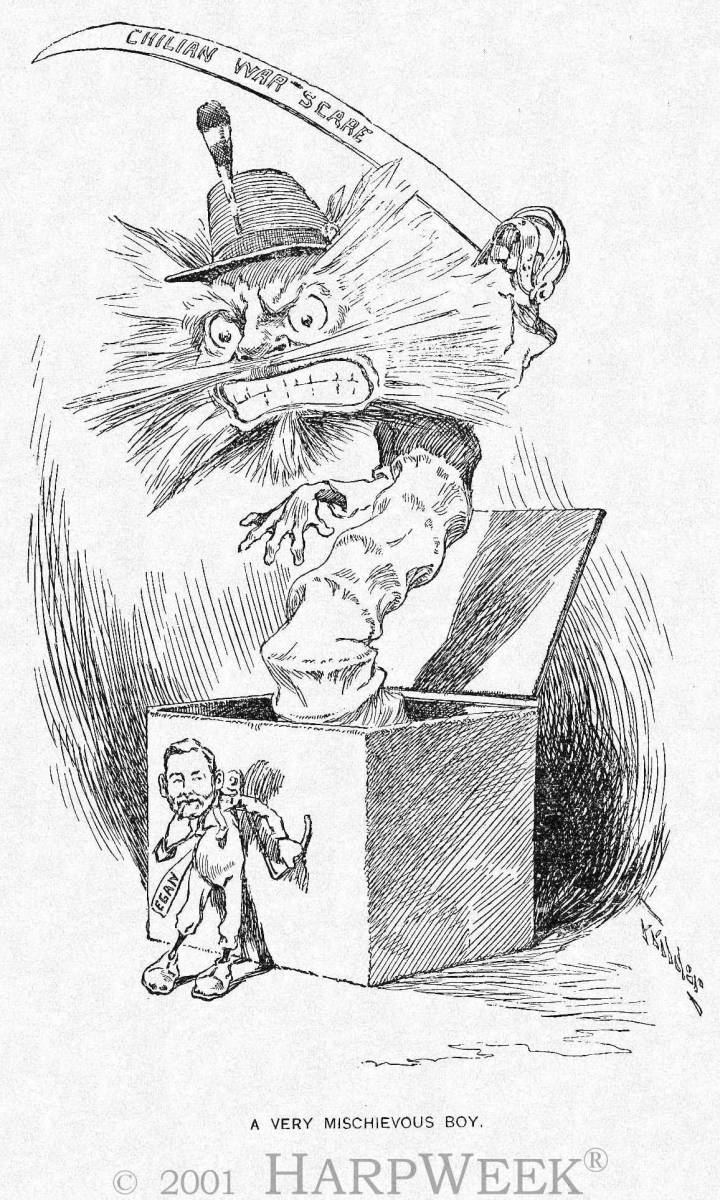
Harper's Weekly
November 14, 1891
A Very Mischievous Boy
Artist: Herbert Merill Wilder

Harper's Weekly
November 14, 1891
A Very Mischievous Boy
Artist: Herbert Merill Wilder
On October 16, 1891, outside the True Blue Saloon in Valparaiso, Chile,
a brawl between American sailors and Chilean nationals resulted in two
American sailors killed, 17 wounded (five seriously), and many arrested.
The
incident sparked a diplomatic crisis that lasted for months, occasionally
threatening war between the two countries, until a settlement was reached
in
early 1892. The featured cartoon blames Patrick Egan, the U.S. minister
to
Chile, by portraying him as a mischievous boy who has cranked up a
menacing Jack-in-the-box, which wields a sword labeled “Chilian War
Scare.”
Tension in the U.S.-Chilean relationship dated back at least a decade to
the
tenure of James G. Blaine as secretary of state under Presidents James
A.
Garfield and Chester Arthur (March-December 1881). Blaine had supported
Peru against Chile in the War of the Pacific (1879-1884), charging that
Chile’s military aggression was encouraged by Great Britain. Hoping
to
enhance American trade in Latin America, Blaine criticized British economic
interests in Chile. Chileans nationalists shared Blaine’s anti-British
sentiment,
but distrusted the American secretary’s motives. Chile and the United
States
were also on a collision course because influential elements in each hoped
to
make their respective country the dominant power in South America.
In March 1889, President Benjamin Harrison (1889-1893) named Blaine
secretary of state. Blaine was pleased to find that the new Chilean
president,
José Manuel Balmaceda, was seeking to undermine British influence
through a
nationalistic campaign of “Chile for Chileans.” To further “twist
the [British]
Lion’s tail,” the secretary of state named Patrick Egan as the U.S. minister
to
Chile. Egan had fled Ireland in 1882 when the British government
issued an
arrest warrant against him for alleged crimes committed in the service
of Irish
independence. In the United States, Egan obtained American citizenship
and
backed the political aspirations of Blaine (who was the Republican
presidential nominee in 1884).
When civil war erupted in Chile in early 1891, the United States threw
its
support to the Balmaceda government, while Britain backed the rebel faction
called the “Congressionalists”. In May 1891, the U.S. government
responded to a request from the Balmaceda government to apprehend a rebel
Chilean ship, the Itata, which had loaded a shipment of arms in San Diego,
California. The Congressionalists won the civil war, and the Harrison
government released the ship in July and recognized the new Chilean
government in August.
Tensions remained high, however, and the U.S. Navy Department considered
contingency plans in case of war. Part of the friction stemmed from
Egan’s
grant of asylum in the American mission to several leaders of the defeated
Balmaceda faction. By October, only 15 of the original 80 refugees
remained
at the mission, but Egan refused an order from the Chilean government to
surrender them. In response, the Chilean secret police surrounded
the
building to prevent the refugees’ escape.
On October 16, the captain of the U.S.S. Baltimore gave shore leave to
117
American sailors in Valparaiso, Chile’s second most populous city and an
important port. Later that day, an altercation between an American
sailor and
a Chilean sailor escalated into a riot involving numerous sailors, boatmen,
longshoremen, and townspeople. Both sides blamed the other for initiating
the violence, but American sources suspected a planned assault on American
sailors.
President Harrison, already angered by the refugee dispute, became furious
over the Baltimore affair. The United States government demanded
“prompt
and full reparation,” but the Chilean foreign minister, Manuel Matta, promised
nothing until the judicial process was completed. Secretary of State
Blaine,
who had been absent since May due to illness, returned to duty on October
26 and, to his critics' surprise, urged caution and patience during the
diplomatic crisis.
The situation cooled somewhat for several weeks until a war of words
erupted in early December. In his annual address to Congress, President
Harrison blamed Chile for the Baltimore affair and criticized the “offensive
tone” of Chilean foreign minister Matta. Navy Secretary Benjamin
Tracy
echoed the president’s sentiments. Matta responded publicly on December
11 by declaring that the American government was insincere, wrong, and
bellicose. That further incensed Harrison, and Egan broke off communication
with the Chilean government, which intensified its surveillance of the
American
mission.
Harrison stepped back from the brink of war when Blaine insisted that no
additional demands be made immediately on Chile, and when a newly
installed Chilean administration replaced Matta on January 1, 1892, with
a
more conciliatory foreign minister, Luis Pereira. Pereira met cordially
with
Egan, the secret police were removed from the American mission, and the
refugees were allowed to leave the country without arrest. On January
8, a
Chilean court indicted three Chileans and one American for their involvement
in the Baltimore affair.
With an end to the diplomatic dispute in sight, on January 20 the new Chilean
government ineptly called for the removal of Egan as U.S. minister.
Harrison,
this time with Blaine’s approval, sent a strongly worded message to Chile,
rejecting the Chilean court’s findings, calling the Baltimore incident
a
deliberate attack on uniformed American servicemen, refusing to discuss
Egan’s position, and demanding “a suitable apology and … adequate
reparation for the injury done to this Government.”
On January 25, the Chilean administration, warned by European ministers
that
the Americans were poised for war, conceded all points. In February
1892,
a Chilean court handed down prison sentences for the three indicted Chilean
rioters, and in July the Chilean government offered to pay the United States
$75,000 in reparations, which the Harrison administration accepted.
Egan
remained as the U.S. minister until fired by President Grover Cleveland
in
1893 after he again offered asylum during another Chilean civil war.
Robert C. Kennedy